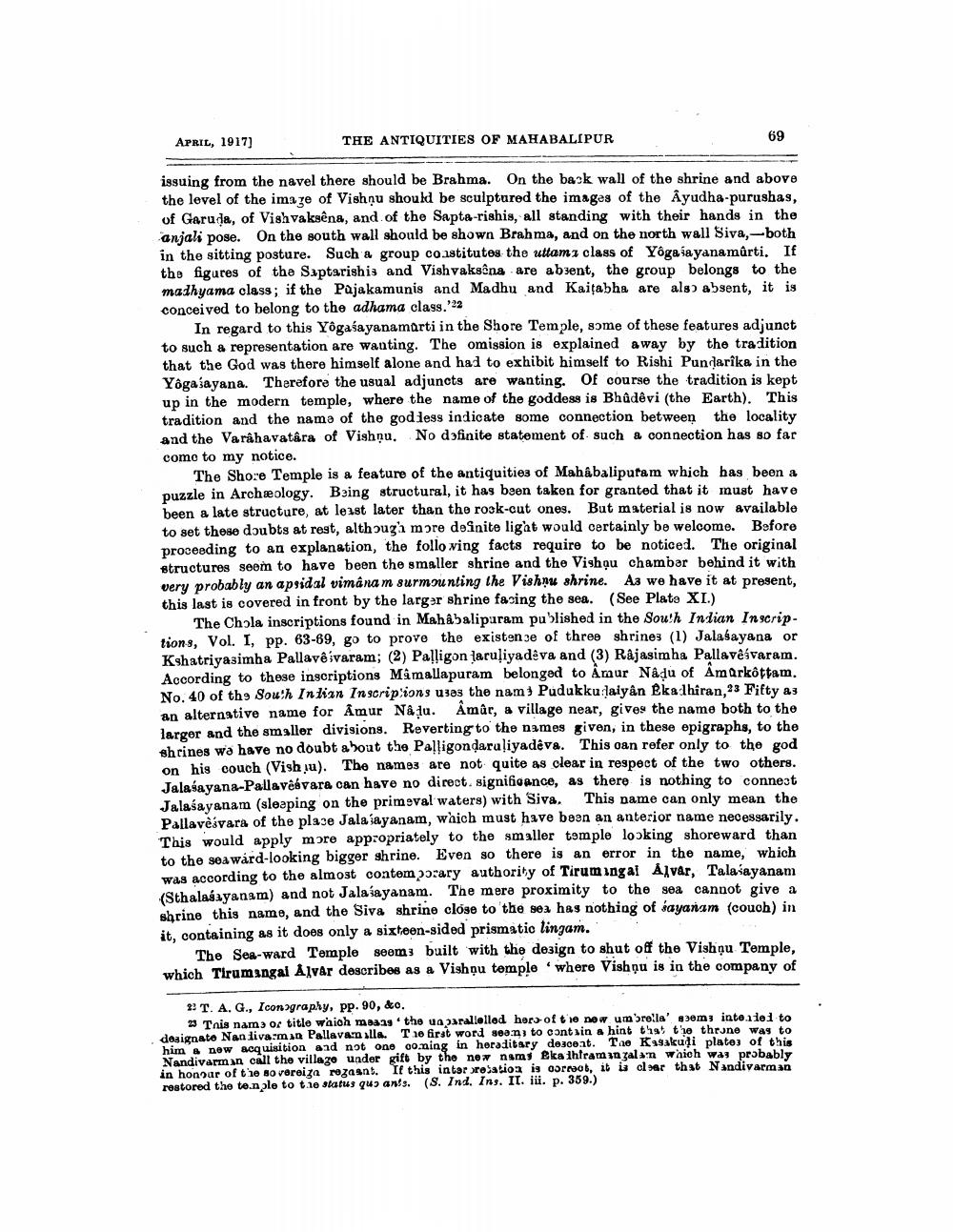________________
APRIL, 1917]
THE ANTIQUITIES OF MAHABALIPUR
69
issuing from the navel there should be Brahma. On the back wall of the shrine and above the level of the image of Vishnu should be sculptured the images of the Ayudha-purushas, of Garuda, of Vishvaksêna, and of the Sapta-rishis, all standing with their hands in the anjali pose. On the south wall should be shown Brahma, and on the north wall Siva,-both in the sitting posture. Such a group constitutes the uttam class of Yogaiayanamurti. If the figures of the Saptarishis and Vishvaksêna are absent, the group belongs to the madhyama class; if the Pajakamunis and Madhu and Kaitabha are also absent, it is conceived to belong to the adhama class.'22
In regard to this Yogaśayanamarti in the Shore Temple, some of these features adjunct to such a representation are wanting. The omission is explained away by the tradition that the God was there himself alone and had to exhibit himself to Rishi Pundarîka in the Yôgasayana. Therefore the usual adjuncts are wanting. Of course the tradition is kept up in the modern temple, where the name of the goddess is Bhûdêvi (the Earth). This tradition and the name of the godless indicate some connection between the locality and the Varâhavatara of Vishnu. No definite statement of such a connection has so far come to my notice.
The Shore Temple is a feature of the antiquities of Mahabalipuram which has been a puzzle in Archæology. Being structural, it has been taken for granted that it must have been a late structure, at least later than the rock-cut ones. But material is now available to set these doubts at rest, although more definite light would certainly be welcome. Before proceeding to an explanation, the following facts require to be noticed. The original structures seem to have been the smaller shrine and the Vishau chamber behind it with very probably an apsidal vimanam surmounting the Vishnu shrine. As we have it at present, this last is covered in front by the larger shrine facing the sea. (See Plate XI.)
The Chola inscriptions found in Mahabalipuram published in the South Indian Inscriptions, Vol. I, pp. 63-69, go to prove the existence of three shrines (1) Jalasayana or Kshatriyasimha Pallavêivaram; (2) Palligon laruliyadeva and (3) Râjasimha Pallavesvaram. According to these inscriptions Mamallapuram belonged to Amur Nâḍu of Amarkottam. No. 40 of the South Indian Inscriptions uses the nam3 Pudukkulaiyân Ekadhiran, 23 Fifty as an alternative name for Amur Nâu. Âmûr, a village near, gives the name both to the larger and the smaller divisions. Reverting to the names given, in these epigraphs, to the shrines we have no doubt about the Palligondaraliyadêva. This oan refer only to the god on his couch (Vishu). The names are not quite as clear in respect of the two others. Jalasayana-Pallavêévara can have no direct. significance, as there is nothing to connect This name can only mean the Jalaśayanam (sleeping on the primeval waters) with Siva. Pallavesvara of the place Jalajayanam, which must have been an anterior name necessarily. This would apply more appropriately to the smaller temple looking shoreward than to the seaward-looking bigger shrine. Even so there is an error in the name, which was according to the almost contemporary authority of Tirumingai Alvar, Talasayanam (Sthalasayanam) and not Jalasayanam. The mere proximity to the sea cannot give a shrine this name, and the Siva shrine close to the sea has nothing of sayanam (couch) in it, containing as it does only a sixteen-sided prismatic lingam.
The Sea-ward Temple seems built with the design to shut off the Vishnu Temple, which Tirumangal Alvar describes as a Vishnu temple where Vishnu is in the company of
2: T. A. G., Iconography, pp. 90, &c.
23 This name or title which means the unparallelled hero of the new umbrella' seems intended to designate Nan divarman Pallavamalla. The first word seems to contain a hint that the throne was to him a new acquisition and not one coming in hereditary descent. Tae Kasakudi plates of this Nandivarman call the village under gift by the new nams Ekathiramangalam which was probably in honour of the sovereiga regasnt. If this interrelation is oorrect, it is clear that Nandivarman restored the te.nple to the status quo ants. (S. Ind. Ins. II. iii. p. 359.)




